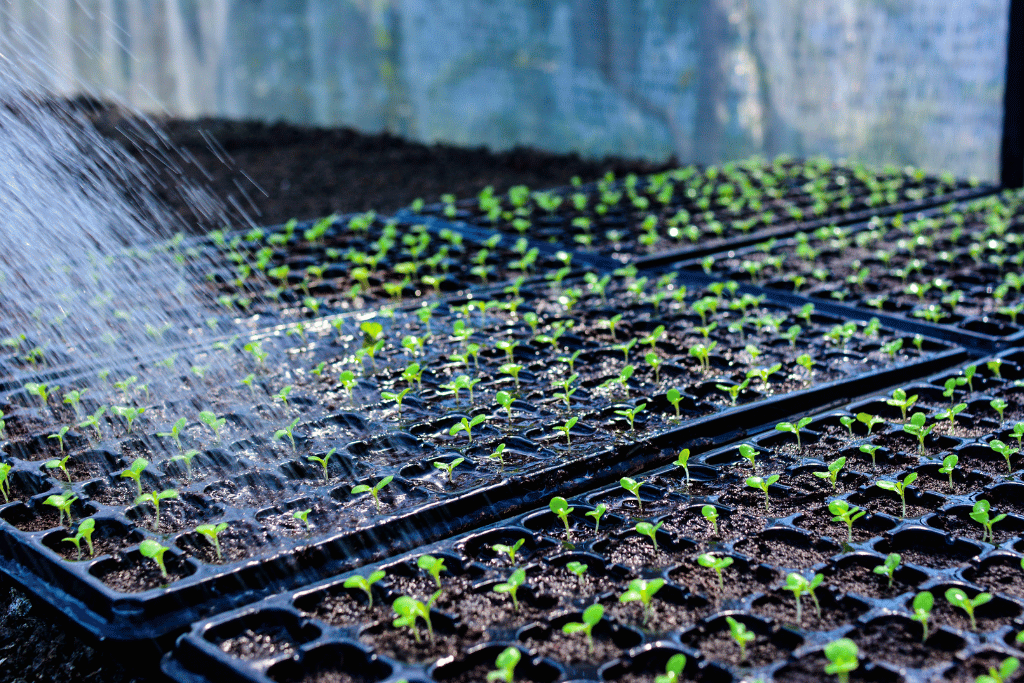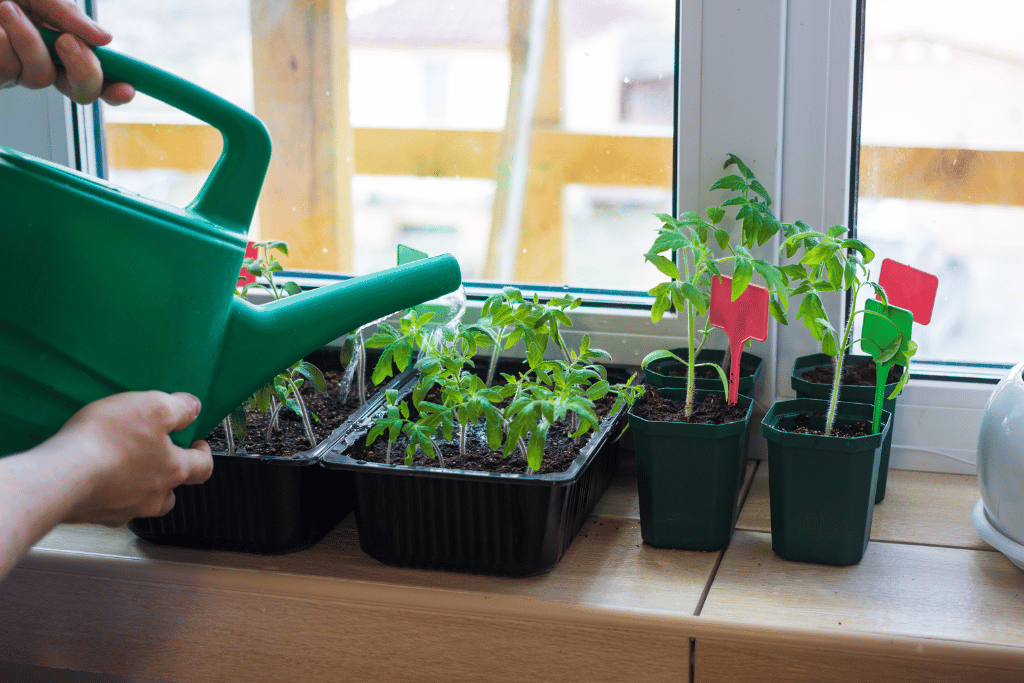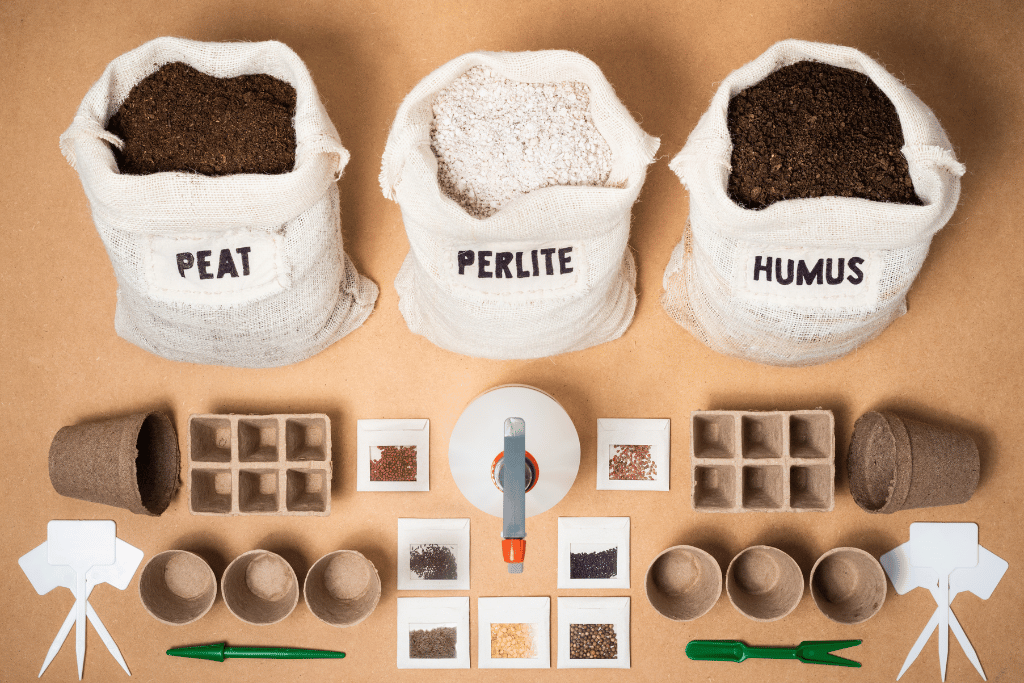
Every year I start seeds inside to get a jump on the growing season. I always plant tomato and pepper seeds and a handful of other vegetables that I enjoy growing in the garden.
I’m also constantly growing new batches of microgreens, which start from a seed and are ready to harvest in under two weeks.
So as you might imagine, I’m continuously starting and caring for seeds all throughout the year. And it never ceases to amaze me when I see a tiny little seed crack open and push its way up through the soil.
What an inspiration!
Providing seeds with water and warmth is the critical factor to make sure your baby plants get off to a strong start.
When you’ve started as many seeds as I have over the years you’re bound to make some mistakes.
And boy have I made some big ones!
Overwatering and drowning a whole tray of tomato plants or underwatering and letting an entire crop of peppers die of thirst. So many major disappointments, but you have to fail to learn and grow.
So when I get asked how often to water seedlings, I can confidently say “Every day, but…”
Most seedlings require that their soil always stays moist and that’s why it’s important to keep them well-watered.
But… many factors can change the frequency of your watering schedule.
With all that said, let’s get down and dirty into all the details of watering seedlings.
How Often to Water Seedlings
Seedlings are a living, growing contradiction. Strong, energetic and vital, yet at the same time fragile, feeble and dependent.
They can sprout under difficult circumstances and are resilient to less-than-ideal conditions. But they do require three things to survive and will die quickly if these elements lack or are out of balance.
Welcome to the unpredictable world of seed starting!
Water, warmth and light in the right proportions will set the stage for a healthy start to a plant’s life. Getting the watering just right is most likely going to be the most challenging aspect of caring for your seedlings.
The temperature, size of your containers and exposure to outside elements will ultimately dictate how often you should water your seedlings. A reasonable expectation is that you’ll be watering your seedlings once per day.
But this won’t always be the case.
For example, yesterday my tray of tomato seeds looked a little dry and some were really taking their time in sprouting. So I gave them a really thorough dousing and the soil starting mix is still soaked today. I’m actually a little bit concerned I overwatered but they look alright. So, I’m going to skip watering today, wait until tomorrow and check again.

Close observation and trial and error are a big part of getting the process down pat.
Watering seeds and seedlings can be a tricky task. Though once you get the hang of it and understand the needs of the plant, it’s simple.
Seeds require plenty of moisture to sprout, establish roots and thrive. With a good seed starting mix, it should be difficult to overwater. That said, your medium shouldn’t be completely soaked at all times.
Water just until it starts coming out of the drainage holes. As seedlings get bigger, they’ll use up water at a quicker rate. Water well and keep an eye on the consistency of the medium. Let it dry out slightly before another thorough watering.
Sitting in pools of excess water will negatively affect root growth and invite fungal diseases and damping off. Proper air ventilation is imperative for moderating humidity and deterring disease.
Signs That Your Seedlings Need More Water

Because seedlings are barely established, they have a tiny root system that can’t survive being dried out for any period of time. Keep a look out for these signs. If you notice any, give your seedlings water asap.
Drooping Plants
At this early stage of growing, looks won’t deceive. If your plants look withered and start to droop, feel the soil. If it’s dry, give them a slow, gentle and thorough watering as soon as you can.
Light Trays
When checking on your plants, lift the trays or pots they’re planted in. If they feel light, they probably are on the dryer side and need water. If they have some weight to them, it should be safe to let them go another day without watering. After a while, you’ll be able to tell if they need water or not just by feeling how heavy the trays are.
The Top Half Inch of the Soil Is Dry
Shallow seedling roots need constant moisture. When the top layer of soil dries out, it’s time to water. Prevent the root system from drying out at all costs. The soil usually takes on a lighter color when it’s dry; you can insert your finger to feel for the moisture level.
Bottom watering is a good option for underwatered seeds, as dried-out soil will take a long time to absorb water.
Bottom Watering
Trays and starter pots are usually kept inside another tray to catch runoff water. This second solid tray can also be used for distributing water. Lift up the top tray with the seedlings and pour water directly into the bottom tray.
This is a gentle way to gradually water your seedlings. Bottom watering helps you regulate the amount given. When the soil gets to the desired moisture level, any excess water in the tray can be dumped out.
Bottom watering is especially helpful when seedlings are still small and fragile.
Overhead Watering

Watering from above with a mister or watering can might be a little daunting when it comes to your precious seedlings.
Misting works great for getting seeds started, but as seedlings grow, they’re going to need something with a heavier flow.
Indoor watering cans with a thin neck or fine water-breaking holes will work fine.
Just be sure always to go slow. The light seed starting mix can easily be disturbed and the seedlings themselves are still fragile as well.
Overwatered Seedlings
If your seedlings have been overwatered, it can lead to many problems that could result in their death. Drowning, mold, root rot, damping off and pests result from too much water. Often times these issues cannot be corrected.
That’s why it’s so important to use a well-drained medium and only water after it begins to dry out a bit.
To try to save overwatered seedlings move them to a bright, dry area with plenty of circulating air.
The Best Seed Starting Mix

An excellent seed starting mix will make your life a million times easier. The medium you use should retain just the right amount of moisture while draining off any excess.
Seed starting mixes are available at any grow store, garden center or home improvement outfit. Generally, they’re good quality and worth the investment.
Some great quality ingredients to look for are:
- sphagnum peat moss
- vermiculite
- perlite
- coco coir
- mycorrhizae
- compost
- humus
- earthworm castings
You can even make your own custom mix, as all of these ingredients are readily available. A breakdown of the perfect ratio is:
- ⅓ moisture retention (peat moss, coco coir)
- ⅓ drainage (vermiculite, perlite, sand)
- ⅓ organic matter (compost, humus, earthworm castings)
Other organic ingredients to consider sprinkling into your mix are azomite and diatomaceous earth to add a bit of micronutrients and pest-fighting capacity.
All of these substances are pretty neutral as far as nutrients go, which is a good thing for young seedlings. Anything too hot could shock, stunt or kill the tender new plants. There will be time as the seedling matures to fertilize lightly and transplant into more nutrient-rich soil.
Don’t use soil from your garden to start seeds indoors. It’s important that the seed starting mix is sterile so that no disease or pests are transferred to the seedlings.
Mixes with an acidic pH of around 5.5 – 6.5 will give the best results.
Top Tips for Watering Seedlings

Since there is no one-size-fits-all solution for how often to water seedlings, I’ve compiled as much relevant information as possible for you to make the best-educated decision for yourself.
Here’s one last list of our best tips to help you get it just right.
- Your seed starting mix will be the foundation for success. Choose a good quality product or make your own blend with the recipe above.
- Before planting, fill your trays or starter pots with a pre-moistened medium. Put your seed starting mix into a bucket or tub, add water and stir it up until it’s evenly moist.
- If you’re worried about overwatering or damaging your plants, try bottom watering.
- Don’t let the temperature get too low or go too high. A warm room temperature in the 70s is perfect.
- Use properly sized trays and pots to start seeds. If they’re too big excess moisture can linger. If they’re too small, they might dry out too quickly.
- Water the entire container evenly. The edges tend to dry out quicker, whereas moisture can pool and sit in the center.
- Always provide air movement with fans. This prevents mold spores from settling, strengthens seedlings and prevents the soil from becoming stagnant.
- Water in the morning so seedlings can take up water during their active growing time and the soil can dry out a bit before the cooler evening.
Getting It Just Right

Figuring out how often to water seedlings seems like it should be a simple task that anybody can manage. That’s true in a sense, but in other ways, it can be the most difficult undertaking in the entire gardening process.
So if you’re wet behind the ears when it comes to seed starting, the best way to learn is by diving right in and getting your hands dirty. Trial and error, successes and failures and experience are the ultimate teachers.
So, what seeds will you start in January this year?



